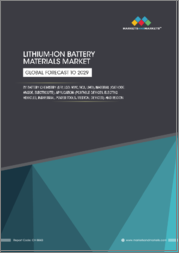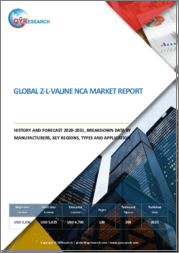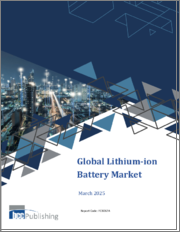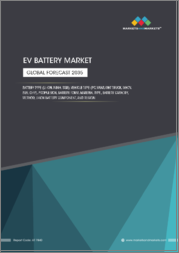
|
시장보고서
상품코드
1678867
세계의 리튬이온 배터리 재료 시장 예측(-2029년) : 재료별, 용도별, 배터리 화학별, 지역별Lithium-ion Battery Materials Market by Battery Chemistry (LFP, LCO, NMC, NCA, LMO), Material (Cathode, Anode, Electrolyte), Application (Portable Device, Electric Vehicle, Industrial, Power Tool, Medical Device), & Region - Global Forecast to 2029 |
||||||
세계의 리튬이온 배터리 재료 시장 규모는 2024년 419억 달러에서 2029년에는 1,209억 달러로 성장하며, 예측 기간 중 CAGR은 23.6%로 예측됩니다.
리튬이온 배터리 재료 시장은 다양한 산업 분야에서 리튬이온 배터리에 대한 수요가 증가함에 따라 빠르게 성장하고 있습니다. 양극재, 음극재, 전해질, 분리막을 포함한 이들 재료는 전기자동차(EV), 가전제품, 에너지 저장 시스템에 사용되는 배터리를 제조하는 데 필요합니다. 이 시장의 주요 촉진요인은 전 세계 탄소 배출량 감축 시도와 재생 에너지에 대한 추세로 인해 EV의 채택이 증가하고 있다는 점입니다. 또한 휴대용 전자기기에 대한 수요 증가, 배터리 기술의 발전, 친환경 에너지를 장려하는 정부의 인센티브가 이 산업을 발전시키고 있습니다.
| 조사 범위 | |
|---|---|
| 조사 대상연도 | 2018-2029년 |
| 기준연도 | 2023년 |
| 예측 기간 | 2024-2029년 |
| 대상 단위 | 금액(10억 달러) 및 수량(킬로톤) |
| 부문 | 재료별, 용도별, 배터리 화학별, 지역별 |
| 대상 지역 | 아시아태평양, 유럽, 북미, 기타 지역 |
휴대용 기기 부문은 예측 기간 중 두 번째 점유율을 차지할 것으로 예상됩니다. 스마트폰, 태블릿, 노트북 등 가전제품 수요 증가로 인해 휴대용 전자기기 부문은 리튬이온 배터리 재료 시장에서 두 번째로 큰 비중을 차지할 것으로 예상됩니다. 원격 근무의 확산, 온라인 교육, 스마트 기기에 대한 욕구 증가 등의 요인이 휴대용 전자기기에 대한 수요를 촉진하고 있으며, 이는 효율적이고 오래 지속되는 리튬이온 배터리에 대한 수요를 촉진하고 있습니다. 배터리 수명이 길고 고성능 기기를 선호하는 소비자가 증가함에 따라 휴대용 기기 산업에서 리튬이온 배터리 재료에 대한 수요는 계속 증가할 것으로 예상됩니다.
배터리 화학별로 리튬 인산철 부문은 안전성, 높은 사이클 수명, 비용 효율성으로 인해 리튬이온 배터리 재료 시장에서 두 번째 점유율을 차지할 것으로 예상됩니다. 이 배터리는 과열에 강하고 고온에서도 안정적이기 때문에 에너지 저장 시스템, 전기버스 및 특정 전기자동차에 사용하기에 적합합니다. 또한 재생 에너지의 통합과 그리드 규모의 에너지 저장 시스템에 대한 관심이 높아지면서 안전하고 내구성이 뛰어난 리튬 인산철 배터리의 개발이 촉진되고 있습니다. 지속가능성과 에너지 효율에 대한 전 세계의 관심이 높아짐에 따라 리튬이온 배터리 재료, 특히 리튬 인산철 배터리에 사용되는 재료에 대한 수요가 크게 증가할 것으로 예상됩니다.
전해질 소재는 배터리의 성능과 안전성에 있으며, 중요하므로 리튬이온 배터리 재료 시장에서 두 번째 점유율을 차지할 것으로 예상됩니다. 전해질은 음극과 양극 사이에 리튬이온이 흐르게 하는 것으로 에너지 저장과 방전에 필요한 과정입니다. 특히 전기자동차 및 에너지 저장 시스템 등의 분야에서 고성능 리튬이온 배터리의 필요성이 증가함에 따라 혁신적인 전해질 소재의 필요성도 증가하고 있습니다. 이러한 화합물은 배터리의 효율, 수명 및 안전성을 향상시키는 데 필수적입니다. 전해질 부문의 확대는 고체 전해질 및 고전압 전해질과 같은 전해질 배합의 혁신을 촉진하여 전체 리튬이온 배터리 재료 시장을 촉진하고, 배터리 성능을 개선하며, 새로운 응용 기회를 창출할 수 있습니다.
북미는 전기자동차(EV)에 대한 수요 증가와 재생에너지 솔루션에 대한 관심이 높아지면서 리튬이온 배터리 재료 시장에서 두 번째로 큰 점유율을 차지할 것으로 예상됩니다. 이산화탄소 배출량을 줄이고 지속가능한 운송을 촉진하기 위한 정부의 인센티브가 전기자동차 시장의 성장을 가속하고 있으며, 제조업체와 소비자 모두 리튬이온 배터리 기술을 사용하도록 장려하고 있습니다. 또한 태양광 및 풍력 등 재생 에너지의 통합이 증가함에 따라 효과적인 에너지 저장 솔루션이 필요해지면서 리튬이온 배터리와 그 재료에 대한 수요가 증가하고 있습니다.
세계의 리튬이온 배터리 재료 시장에 대해 조사했으며, 재료별, 용도별, 배터리 화학별, 지역별 동향 및 시장에 참여하는 기업의 개요 등을 정리하여 전해드립니다.
목차
제1장 서론
제2장 조사 방법
제3장 개요
제4장 주요 인사이트
제5장 시장 개요
- 서론
- 시장 역학
제6장 업계 동향
- 세계 거시경제 전망
- 밸류체인 분석
- 에코시스템 분석
- Porter's Five Forces 분석
- 가격 분석
- 관세와 규제 상황
- 2024-2025년의 주요 컨퍼런스와 이벤트
- 주요 이해관계자와 구입 기준
- 특허 분석
- 기술 분석
- 무역 분석
- 사례 연구 분석
- 생성형 AI의 영향
제7장 리튬이온 배터리 재료 시장(재료별)
- 서론
- 양극 재료
- 음극 재료
- 전해질 재료
- 기타
제8장 리튬이온 배터리 재료 시장(용도별)
- 서론
- 휴대용 디바이스
- 전기자동차
- 산업
- 기타
제9장 리튬이온 배터리 재료 시장(배터리 화학별)
- 서론
- 리튬 니켈 망간 코발트
- 인산철리튬
- 망간산리튬
- 리튬 니켈 코발트 알루미늄 산화물
- 리튬 코발트 산화물
제10장 리튬이온 배터리 재료 시장(지역별)
- 서론
- 유럽
- 독일
- 영국
- 프랑스
- 기타
- 아시아태평양
- 중국
- 일본
- 인도
- 한국
- 기타
- 북미
- 미국
- 캐나다
- 멕시코
- 기타 지역
- 남미
- 중동 및 아프리카
제11장 경쟁 구도
- 서론
- 주요 참여 기업의 전략/강점(2020년 1월-2024년 7월)
- 매출 분석, 2019-2023년
- 시장 점유율 분석, 2023년
- 브랜드/제품 비교
- 기업 평가 매트릭스 : 주요 참여 기업, 2023년
- 기업 평가 매트릭스 : 스타트업/중소기업, 2023년
- 기업 가치 평가와 재무 지표
- 경쟁 시나리오
제12장 기업 개요
- 주요 참여 기업
- UMICORE
- SUMITOMO METAL MINING CO., LTD.
- BASF SE
- POSCO FUTURE M
- TANAKA CHEMICAL CORPORATION
- TODA KOGYO CORP.
- RESONAC HOLDINGS CORPORATION
- L&F CO., LTD.
- JFE CHEMICAL CORPORATION
- 3M
- SGL CARBON
- NEI CORPORATION
- KUREHA CORPORATION
- BTR NEW MATERIAL GROUP CO., LTD.
- UBE CORPORATION
- KURARAY CO., LTD.
- SHENZHEN DYNANONIC CO., LTD.
- ZHEJIANG HUAYOU COBALT
- AMERICAN ELEMENTS
- MORITA CHEMICAL INDUSTRIES CO., LTD.
- 기타 기업
- ECOPRO BM
- CAPCHEM
- NICHIA CORPORATION
- ASCEND ELEMENTS, INC.
- PULEAD TECHNOLOGY INDUSTRY CO., LTD.
제13장 인접 시장과 관련 시장
제14장 부록
KSA 25.03.24The global lithium-ion battery materials market is projected to grow from USD 41.9 billion in 2024 to USD 120.9 billion by 2029, at a CAGR of 23.6% during the forecast period. The lithium-ion battery materials market is expanding rapidly due to rising demand for lithium-ion batteries across a variety of industries. These materials, which include cathode and anode materials, electrolytes, and separators, are required to produce batteries used in electric vehicles (EVs), consumer electronics, and energy storage systems. The key drivers of this market are the rising adoption of EVs, which is being driven by worldwide attempts to reduce carbon emissions and a trend toward renewable energy. Furthermore, rising demand for portable electronic devices, advances in battery technology, and government incentives to promote green energy are moving the industry forward.
| Scope of the Report | |
|---|---|
| Years Considered for the Study | 2018-2029 |
| Base Year | 2023 |
| Forecast Period | 2024-2029 |
| Units Considered | Value (USD Billion) and Volume (Kilotons) |
| Segments | Application, Battery Chemistry, Material, and Region |
| Regions covered | Asia Pacific, Europe, North America, and Rest of World |
"Portable devices segment, by application, is estimated to account for the second largest share during the forecast period"
The portable devices segment is projected to secure the second-largest share in the forecast period. Given the growing demand for consumer electronics such as smartphones, tablets, and laptops, the portable devices category is predicted to account for the second-largest proportion of the lithium-ion battery materials market. Factors such as the expanding popularity of remote work, online education, and the growing desire for smart gadgets are driving demand for portable electronics, which in turn fuels the demand for efficient and long-lasting lithium-ion batteries. The growing preference among consumers for high-performance devices with extended battery life will continue to boost demand for lithium-ion battery materials in the portable device industry.
"By battery chemistry, lithium iron phosphate segment is accounted for the second largest share during the forecast period"
The lithium iron phosphate segment by battery chemistry is expected to have the second-largest share of the lithium-ion battery materials market, owing to its safety features, high cycle life, and cost-effectiveness. These batteries are less prone to overheating and provide stability even at high temperatures, making them excellent for use in energy storage systems, electric buses, and certain electric automobiles. Furthermore, the increased emphasis on renewable energy integration and grid-scale energy storage systems is encouraging the development of lithium iron phosphate batteries, which are safe and durable. As the global focus on sustainability and energy efficiency grows, demand for lithium-ion battery materials, particularly those used in lithium iron phosphate batteries, is predicted to increase significantly.
"Electrolyte materials segment, by material, is estimated to account for the second largest share during the forecast period"
Electrolyte materials are expected to account for the second-largest share of the lithium-ion battery materials market due to their significance in battery performance and safety. Electrolytes allow lithium ions to flow between the anode and cathode, a process required for energy storage and discharge. As the need for high-performance lithium-ion batteries grows, especially in applications such as electric vehicles and energy storage systems, so does the need for innovative electrolyte materials. These compounds are critical to increasing battery efficiency, longevity, and safety. The expansion of the electrolyte segment will propel the overall lithium-ion battery materials market by driving innovations in electrolyte formulations, such as solid-state and high-voltage electrolytes, which improve battery performance and open up new application opportunities.
"North America region is estimated to account for the second largest share during the forecast period"
North America is expected to have the second-largest share of the lithium-ion battery materials market, owing to the region's strong demand for electric vehicles (EVs) and growing emphasis on renewable energy solutions. Government incentives to reduce carbon emissions and promote sustainable transportation are driving the EV market's growth, encouraging both manufacturers and consumers to use lithium-ion battery technologies. Furthermore, the increasing integration of renewable energy sources, such as solar and wind, needs effective energy storage solutions, driving up demand for lithium-ion batteries and their materials.
Profile break-up of primary participants for the report:
- By Company Type: Tier 1 - 65%, Tier 2 - 20%, and Tier 3 - 15%
- By Designation: C-level- 25%, Director Level- 30%, and Others - 45%
- By Region: North America - 20%, Europe - 15%, Asia Pacific - 55%, Rest of World - 10%
Umicore (Belgium), Sumitomo Metal Mining Co., Ltd. (Japan), BASF SE (Germany), POSCO Future M (South Korea), and Tanaka Chemical Corporation (Japan) are some of the major players operating in the lithium-ion battery materials market. These players have adopted strategies such as acquisitions, expansions, and partnerships in order to increase their market share business revenue.
Research Coverage:
The report defines, segments, and projects the lithium-ion battery materials market based on application, battery chemistry, material, and region. It provides detailed information regarding the major factors influencing the growth of the market, such as drivers, restraints, opportunities, and challenges. It strategically profiles, lithium-ion battery materials manufacturers and comprehensively analyses their market shares and core competencies as well as tracks and analyzes competitive developments, such as expansions, joint ventures, agreements, and acquisitions, undertaken by them in the market.
Reasons to Buy the Report:
The report is expected to help the market leaders/new entrants in the market by providing them the closest approximations of revenue numbers of the lithium-ion battery materials market and its segments. This report is also expected to help stakeholders obtain an improved understanding of the competitive landscape of the market, gain insights to improve the position of their businesses, and make suitable go-to-market strategies. It also enables stakeholders to understand the pulse of the market and provide them information on key market drivers, restraints, challenges, and opportunities.
The report provides insights on the following pointers:
- Analysis of key drivers (growth in production of lithium-ion batteries, surge in demand for consumer electronics), restraints (safety concerns regarding usage of gadgets or items installed with lithium-ion batteries, availability of substitutes), opportunities (growing R&D to enhance efficiency and upgrade lithium-ion batteries, decline in overall prices), and challenges (fluctuating raw material prices) influencing the growth of the lithium-ion battery materials market.
- Product Development/Innovation: Detailed insights on upcoming technologies, research & development activities in the lithium-ion battery materials market.
- Market Development: Comprehensive information about lucrative markets - the report analyses the lithium-ion battery materials market across varied regions.
- Market Diversification: Exhaustive information about new products, various types, untapped geographies, recent developments, and investments in the lithium-ion battery materials market.
- Competitive Assessment: In-depth assessment of market shares, growth strategies and product offerings of leading players such as Umicore (Belgium), Sumitomo Metal Mining Co., Ltd. (Japan), BASF SE (Germany), POSCO Future M (South Korea), Tanaka Chemical Corporation (Japan), Toda Kogyo Corp. (Japan), Resonac Holdings Corporation (Japan), L&F Co., Ltd. (South Korea), JFE Chemical Corporation (Japan), and 3M (US), and others in the lithium-ion battery materials market
TABLE OF CONTENTS
1 INTRODUCTION
- 1.1 STUDY OBJECTIVES
- 1.2 MARKET DEFINITION
- 1.3 STUDY SCOPE
- 1.3.1 INCLUSIONS & EXCLUSIONS
- 1.3.2 YEARS CONSIDERED
- 1.3.3 CURRENCY CONSIDERED
- 1.3.4 UNIT CONSIDERED
- 1.4 LIMITATIONS
- 1.5 STAKEHOLDERS
- 1.6 SUMMARY OF CHANGES
2 RESEARCH METHODOLOGY
- 2.1 RESEARCH DATA
- 2.1.1 SECONDARY DATA
- 2.1.1.1 Key data from secondary sources
- 2.1.2 PRIMARY DATA
- 2.1.2.1 Key data from primary sources
- 2.1.2.2 Breakdown of interviews with experts
- 2.1.1 SECONDARY DATA
- 2.2 DEMAND-SIDE MATRIX
- 2.3 MARKET SIZE ESTIMATION
- 2.3.1 BOTTOM-UP APPROACH
- 2.3.2 TOP-DOWN APPROACH
- 2.3.2.1 Calculations for supply-side analysis
- 2.4 GROWTH FORECAST
- 2.5 DATA TRIANGULATION
- 2.5.1 RESEARCH ASSUMPTIONS
- 2.5.2 RESEARCH LIMITATIONS
- 2.5.3 RISK ASSESSMENT
3 EXECUTIVE SUMMARY
4 PREMIUM INSIGHTS
- 4.1 ATTRACTIVE OPPORTUNITIES FOR PLAYERS IN LITHIUM-ION BATTERY MATERIALS MARKET
- 4.2 LITHIUM-ION BATTERY MATERIALS MARKET, BY REGION
- 4.3 LITHIUM-ION BATTERY MATERIALS MARKET, BY MATERIAL
- 4.4 LITHIUM-ION BATTERY MATERIALS MARKET, BY BATTERY CHEMISTRY
- 4.5 LITHIUM-ION BATTERY MATERIALS MARKET, BY APPLICATION
5 MARKET OVERVIEW
- 5.1 INTRODUCTION
- 5.2 MARKET DYNAMICS
- 5.2.1 DRIVERS
- 5.2.1.1 Increasing adoption of electric vehicles
- 5.2.1.2 Surging demand for consumer electronics
- 5.2.2 RESTRAINTS
- 5.2.2.1 Safety concerns related to gadgets with lithium-ion batteries
- 5.2.2.2 Availability of substitutes
- 5.2.3 OPPORTUNITIES
- 5.2.3.1 Growing R&D to upgrade lithium-ion batteries
- 5.2.3.2 Declining lithium-ion battery prices
- 5.2.4 CHALLENGES
- 5.2.4.1 Fluctuating raw material prices
- 5.2.1 DRIVERS
6 INDUSTRY TRENDS
- 6.1 GLOBAL MACROECONOMIC OUTLOOK
- 6.1.1 GDP
- 6.1.2 RISING ADOPTION OF ELECTRIC VEHICLES
- 6.2 VALUE CHAIN ANALYSIS
- 6.3 ECOSYSTEM ANALYSIS
- 6.4 PORTER'S FIVE FORCES ANALYSIS
- 6.4.1 BARGAINING POWER OF SUPPLIERS
- 6.4.2 BARGAINING POWER OF BUYERS
- 6.4.3 THREAT OF NEW ENTRANTS
- 6.4.4 THREAT OF SUBSTITUTES
- 6.4.5 INTENSITY OF COMPETITIVE RIVALRY
- 6.5 PRICING ANALYSIS
- 6.5.1 AVERAGE SELLING PRICE OF LITHIUM CARBONATE, BY REGION
- 6.5.2 AVERAGE SELLING PRICE OF COBALT, BY REGION
- 6.5.3 AVERAGE SELLING PRICE OF NICKEL, BY REGION
- 6.5.4 AVERAGE SELLING PRICE, BY METAL
- 6.6 TARIFF AND REGULATORY LANDSCAPE
- 6.6.1 TARIFF DATA
- 6.6.2 REGULATORY LANDSCAPE
- 6.6.2.1 Regulatory bodies, government agencies, and other organizations
- 6.6.3 PRACTICES AND POLICES IN LATIN AMERICAN COUNTRIES
- 6.6.3.1 Introduction
- 6.6.3.2 Colombia
- 6.6.3.3 Polices, regulations, and EPR schemes
- 6.6.3.4 Costa Rica
- 6.6.3.5 Polices, regulations, and EPR schemes
- 6.6.3.6 Existing recycling infrastructure and reuse initiatives
- 6.6.3.7 Chile
- 6.6.3.8 Polices, regulations, and EPR schemes
- 6.6.3.9 Existing recycling infrastructure and reuse initiatives
- 6.6.3.10 Mexico
- 6.6.3.11 Polices, regulations, and EPR schemes
- 6.6.3.12 Existing recycling infrastructure and reuse initiatives
- 6.7 KEY CONFERENCES AND EVENTS, 2024-2025
- 6.8 KEY STAKEHOLDERS AND BUYING CRITERIA
- 6.8.1 KEY STAKEHOLDERS IN BUYING PROCESS
- 6.8.2 BUYING CRITERIA
- 6.9 PATENT ANALYSIS
- 6.9.1 METHODOLOGY
- 6.9.2 MAJOR PATENTS
- 6.10 TECHNOLOGY ANALYSIS
- 6.10.1 KEY TECHNOLOGIES
- 6.10.1.1 High-nickel cathodes
- 6.10.2 COMPLEMENTARY TECHNOLOGIES
- 6.10.2.1 Lithium metal batteries
- 6.10.1 KEY TECHNOLOGIES
- 6.11 TRADE ANALYSIS
- 6.11.1 IMPORT SCENARIO (HS CODE 850650)
- 6.11.2 EXPORT SCENARIO (HS CODE 850650)
- 6.12 CASE STUDY ANALYSIS
- 6.12.1 HITACHI'S LESS-VOLATILE ELECTROLYTE ELIMINATES NEED FOR COOLING SYSTEM IN BATTERIES
- 6.13 TRENDS/DISRUPTIONS IMPACTING CUSTOMER BUSINESS
- 6.14 INVESTMENT AND FUNDING SCENARIO
- 6.15 IMPACT OF GENERATIVE AI ON LITHIUM-ION BATTERY MATERIALS MARKET
- 6.15.1 INTRODUCTION
- 6.15.2 IMPACT OF GENERATIVE AI
- 6.15.2.1 Enhanced manufacturing efficiency
- 6.15.2.2 Reduced material waste
- 6.15.2.3 Improved quality control
7 LITHIUM-ION BATTERY MATERIALS MARKET, BY MATERIAL
- 7.1 INTRODUCTION
- 7.2 ANODE MATERIALS
- 7.2.1 GROWING DEMAND FOR LITHIUM-ION BATTERIES TO BOOST MARKET
- 7.3 CATHODE MATERIALS
- 7.3.1 GROWING DEMAND FOR ELECTRIC VEHICLES TO DRIVE MARKET
- 7.4 ELECTROLYTE MATERIALS
- 7.4.1 NEED FOR ENHANCED BATTERY OUTPUT TO DRIVE MARKET
- 7.5 OTHER MATERIALS
8 LITHIUM-ION BATTERY MATERIALS MARKET, BY APPLICATION
- 8.1 INTRODUCTION
- 8.2 PORTABLE DEVICES
- 8.2.1 RAPID TECHNOLOGICAL CHANGES TO DRIVE DEMAND
- 8.3 ELECTRIC VEHICLES
- 8.3.1 GOVERNMENT EFFORTS TO PROMOTE CLEAN ENERGY SOLUTIONS TO DRIVE SEGMENT
- 8.4 INDUSTRIAL
- 8.4.1 FOCUS ON ENVIRONMENTAL SAFETY AND EQUIPMENT DURABILITY TO INCREASE DEMAND
- 8.5 OTHER APPLICATIONS
9 LITHIUM-ION BATTERY MATERIALS MARKET, BY BATTERY CHEMISTRY
- 9.1 INTRODUCTION
- 9.2 LITHIUM NICKEL MANGANESE COBALT
- 9.2.1 HIGH CHARGE & DISCHARGE LIFE TO DRIVE MARKET
- 9.3 LITHIUM IRON PHOSPHATE
- 9.3.1 COST-EFFECTIVENESS AND SUPERIOR PERFORMANCE TO DRIVE DEMAND
- 9.4 LITHIUM MANGANESE OXIDE
- 9.4.1 EXCELLENT SAFETY CHARACTERISTICS TO BOOST MARKET
- 9.5 LITHIUM NICKEL COBALT ALUMINUM OXIDE
- 9.5.1 SUPERIOR CYCLE LIFE TO BOOST DEMAND
- 9.6 LITHIUM COBALT OXIDE
- 9.6.1 WIDE ADOPTION IN CONSUMER ELECTRONICS TO DRIVE MARKET
10 LITHIUM-ION BATTERY MATERIALS MARKET, BY REGION
- 10.1 INTRODUCTION
- 10.2 EUROPE
- 10.2.1 GERMANY
- 10.2.1.1 Growing demand for electric vehicles to drive market
- 10.2.2 UK
- 10.2.2.1 Rising sales of electric vehicles to drive demand
- 10.2.3 FRANCE
- 10.2.3.1 Increasing demand in automotive and marine industries to boost market
- 10.2.4 REST OF EUROPE
- 10.2.1 GERMANY
- 10.3 ASIA PACIFIC
- 10.3.1 CHINA
- 10.3.1.1 Growing production of electric vehicles to drive demand
- 10.3.2 JAPAN
- 10.3.2.1 Presence of leading lithium-ion battery manufacturers to propel market
- 10.3.3 INDIA
- 10.3.3.1 Development of smart cities to drive market
- 10.3.4 SOUTH KOREA
- 10.3.4.1 Government efforts to increase adoption of electric vehicles to fuel market
- 10.3.5 REST OF ASIA PACIFIC
- 10.3.1 CHINA
- 10.4 NORTH AMERICA
- 10.4.1 US
- 10.4.1.1 Rising demand for electric vehicles to fuel market
- 10.4.2 CANADA
- 10.4.2.1 Government subsidies for electric vehicles to boost market
- 10.4.3 MEXICO
- 10.4.3.1 Growing demand in automotive sector to drive market
- 10.4.1 US
- 10.5 REST OF WORLD
- 10.5.1 SOUTH AMERICA
- 10.5.1.1 Large lithium reserves to create market opportunities
- 10.5.2 MIDDLE EAST & AFRICA
- 10.5.2.1 Consumer goods and automobile industries to drive demand
- 10.5.1 SOUTH AMERICA
11 COMPETITIVE LANDSCAPE
- 11.1 INTRODUCTION
- 11.2 KEY PLAYER STRATEGIES/RIGHT TO WIN (JANUARY 2020-JULY 2024)
- 11.2.1 OVERVIEW OF STRATEGIES ADOPTED BY KEY MARKET PLAYERS (JANUARY 2020-JULY 2024)
- 11.3 REVENUE ANALYSIS, 2019-2023
- 11.4 MARKET SHARE ANALYSIS, 2023
- 11.4.1 BASF SE (GERMANY)
- 11.4.2 POSCO FUTURE M (SOUTH KOREA)
- 11.4.3 UMICORE (BELGIUM)
- 11.4.4 SUMITOMO METAL MINING CO., LTD. (JAPAN)
- 11.4.5 RESONAC HOLDINGS CORPORATION (JAPAN)
- 11.5 BRAND/PRODUCT COMPARISON
- 11.5.1 UMICORE
- 11.5.2 SUMITOMO METAL MINING CO., LTD.
- 11.5.3 BASF SE
- 11.5.4 POSCO FUTURE M
- 11.5.5 TANAKA CHEMICAL CORPORATION
- 11.6 COMPANY EVALUATION MATRIX: KEY PLAYERS, 2023
- 11.6.1 STARS
- 11.6.2 EMERGING LEADERS
- 11.6.3 PERVASIVE PLAYERS
- 11.6.4 PARTICIPANTS
- 11.6.5 COMPANY FOOTPRINT: KEY PLAYERS, 2023
- 11.6.5.1 Company footprint
- 11.6.5.2 Region footprint
- 11.6.5.3 Material footprint
- 11.6.5.4 Battery chemistry footprint
- 11.7 COMPANY EVALUATION MATRIX: STARTUPS/SMES, 2023
- 11.7.1 PROGRESSIVE COMPANIES
- 11.7.2 RESPONSIVE COMPANIES
- 11.7.3 DYNAMIC COMPANIES
- 11.7.4 STARTING BLOCKS
- 11.7.5 COMPETITIVE BENCHMARKING, STARTUPS/SMES, 2023
- 11.7.5.1 Lithium-ion battery materials market: Detailed list of key startups/SMEs, 2023
- 11.7.5.2 Lithium-ion battery materials market: Competitive benchmarking of key startups/SMEs, 2023
- 11.8 COMPANY VALUATION AND FINANCIAL METRICS
- 11.9 COMPETITIVE SCENARIO
- 11.9.1 DEALS
- 11.9.2 EXPANSIONS
12 COMPANY PROFILES
- 12.1 KEY PLAYERS
- 12.1.1 UMICORE
- 12.1.1.1 Business overview
- 12.1.1.2 Products offered
- 12.1.1.3 Recent developments
- 12.1.1.3.1 Deals
- 12.1.1.3.2 Expansions
- 12.1.1.4 MnM view
- 12.1.1.4.1 Right to win
- 12.1.1.4.2 Strategic choices
- 12.1.1.4.3 Weaknesses and competitive threats
- 12.1.2 SUMITOMO METAL MINING CO., LTD.
- 12.1.2.1 Business overview
- 12.1.2.2 Products offered
- 12.1.2.3 Recent developments
- 12.1.2.3.1 Deals
- 12.1.2.3.2 Expansions
- 12.1.2.4 MnM view
- 12.1.2.4.1 Right to win
- 12.1.2.4.2 Strategic choices
- 12.1.2.4.3 Weaknesses and competitive threats
- 12.1.3 BASF SE
- 12.1.3.1 Business overview
- 12.1.3.2 Products offered
- 12.1.3.3 Recent developments
- 12.1.3.3.1 Deals
- 12.1.3.3.2 Expansions
- 12.1.3.4 MnM view
- 12.1.3.4.1 Right to win
- 12.1.3.4.2 Strategic choices
- 12.1.3.4.3 Weaknesses and competitive threats
- 12.1.4 POSCO FUTURE M
- 12.1.4.1 Business overview
- 12.1.4.2 Products offered
- 12.1.4.3 Recent developments
- 12.1.4.3.1 Deals
- 12.1.4.3.2 Expansions
- 12.1.4.4 MnM view
- 12.1.4.4.1 Right to win
- 12.1.4.4.2 Strategic choices
- 12.1.4.4.3 Weaknesses and competitive threats
- 12.1.5 TANAKA CHEMICAL CORPORATION
- 12.1.5.1 Business overview
- 12.1.5.2 Products offered
- 12.1.5.3 MnM view
- 12.1.5.3.1 Right to win
- 12.1.5.3.2 Strategic choices
- 12.1.5.3.3 Weaknesses and competitive threats
- 12.1.6 TODA KOGYO CORP.
- 12.1.6.1 Business overview
- 12.1.6.2 Products offered
- 12.1.6.3 Recent developments
- 12.1.6.3.1 Expansions
- 12.1.7 RESONAC HOLDINGS CORPORATION
- 12.1.7.1 Business overview
- 12.1.7.2 Products offered
- 12.1.8 L&F CO., LTD.
- 12.1.8.1 Business overview
- 12.1.8.2 Products offered
- 12.1.8.3 Recent developments
- 12.1.8.3.1 Expansions
- 12.1.9 JFE CHEMICAL CORPORATION
- 12.1.9.1 Business overview
- 12.1.9.2 Products offered
- 12.1.10 3M
- 12.1.10.1 Business overview
- 12.1.10.2 Products offered
- 12.1.11 SGL CARBON
- 12.1.11.1 Business overview
- 12.1.11.2 Products offered
- 12.1.12 NEI CORPORATION
- 12.1.12.1 Business overview
- 12.1.12.2 Products offered
- 12.1.12.3 Recent developments
- 12.1.12.3.1 Product launches
- 12.1.13 KUREHA CORPORATION
- 12.1.13.1 Business overview
- 12.1.13.2 Products offered
- 12.1.14 BTR NEW MATERIAL GROUP CO., LTD.
- 12.1.14.1 Business overview
- 12.1.14.2 Products offered
- 12.1.14.3 Recent developments
- 12.1.14.3.1 Deals
- 12.1.14.3.2 Expansions
- 12.1.15 UBE CORPORATION
- 12.1.15.1 Business overview
- 12.1.15.2 Products offered
- 12.1.15.3 Recent developments
- 12.1.15.3.1 Deals
- 12.1.16 KURARAY CO., LTD.
- 12.1.16.1 Business overview
- 12.1.16.2 Products offered
- 12.1.17 SHENZHEN DYNANONIC CO., LTD.
- 12.1.17.1 Business overview
- 12.1.17.2 Products offered
- 12.1.18 ZHEJIANG HUAYOU COBALT
- 12.1.18.1 Business overview
- 12.1.18.2 Products offered
- 12.1.18.3 Recent developments
- 12.1.18.3.1 Deals
- 12.1.19 AMERICAN ELEMENTS
- 12.1.19.1 Business overview
- 12.1.19.2 Products offered
- 12.1.20 MORITA CHEMICAL INDUSTRIES CO., LTD.
- 12.1.20.1 Business overview
- 12.1.20.2 Products offered
- 12.1.1 UMICORE
- 12.2 OTHER PLAYERS
- 12.2.1 ECOPRO BM
- 12.2.2 CAPCHEM
- 12.2.3 NICHIA CORPORATION
- 12.2.4 ASCEND ELEMENTS, INC.
- 12.2.5 PULEAD TECHNOLOGY INDUSTRY CO., LTD.
13 ADJACENT AND RELATED MARKETS
- 13.1 INTRODUCTION
- 13.2 LIMITATIONS
- 13.3 INTERCONNECTED MARKETS
- 13.4 LITHIUM-ION BATTERY MARKET
- 13.4.1 MARKET DEFINITION
- 13.4.2 MARKET OVERVIEW
- 13.4.3 LITHIUM-ION BATTERY MARKET, BY VOLTAGE
- 13.4.3.1 Low
- 13.4.3.1.1 Built-in battery management to drive demand in consumer electronics
- 13.4.3.2 Medium
- 13.4.3.2.1 Rising adoption in solar energy systems to drive market
- 13.4.3.3 High
- 13.4.3.3.1 Enhanced safety features to boost demand in marine and military sectors
- 13.4.3.1 Low
14 APPENDIX
- 14.1 DISCUSSION GUIDE
- 14.2 KNOWLEDGESTORE: MARKETSANDMARKETS' SUBSCRIPTION PORTAL
- 14.3 CUSTOMIZATION OPTIONS
- 14.4 RELATED REPORTS
- 14.5 AUTHOR DETAILS



















